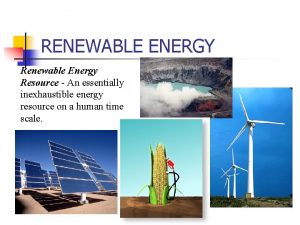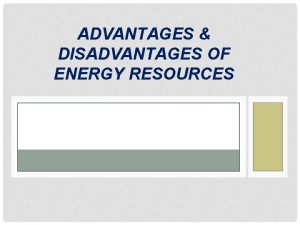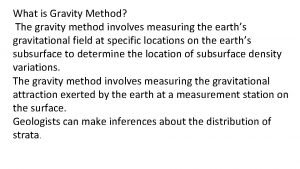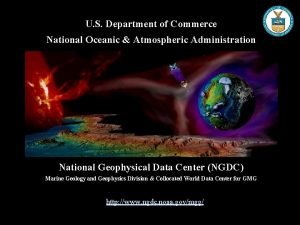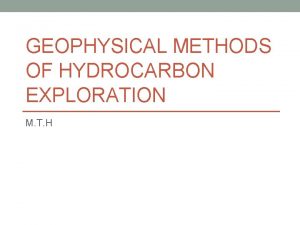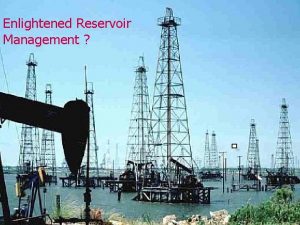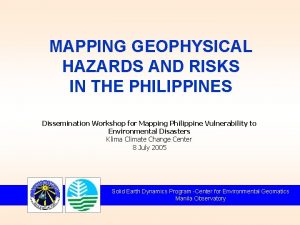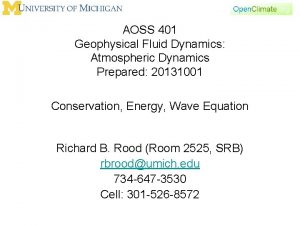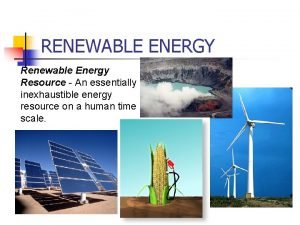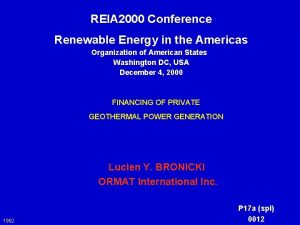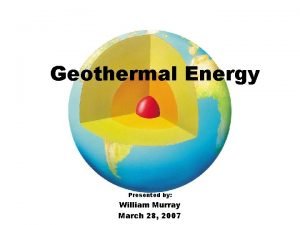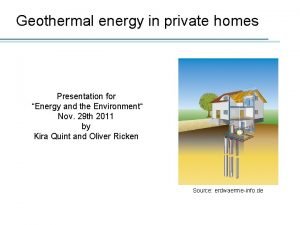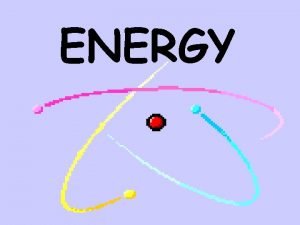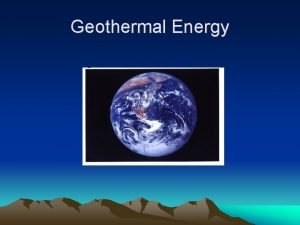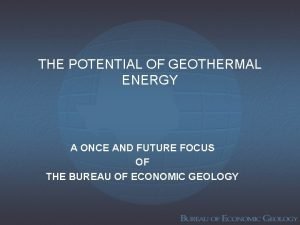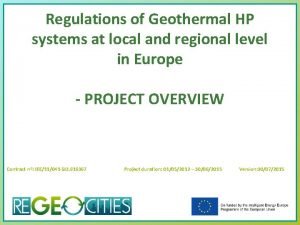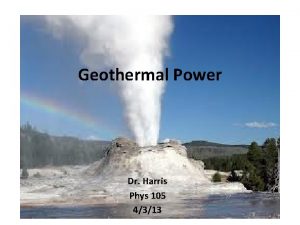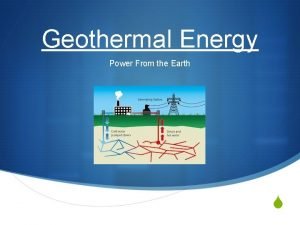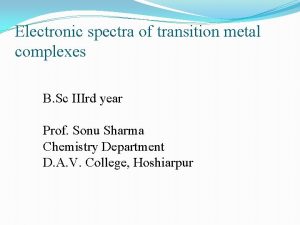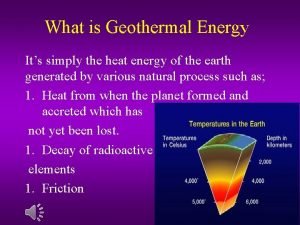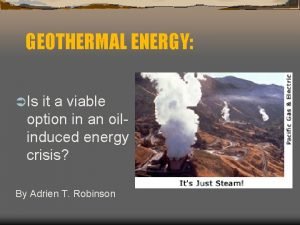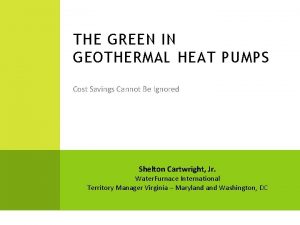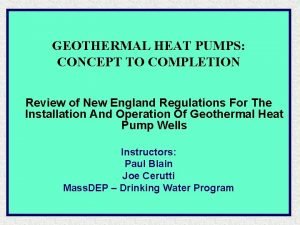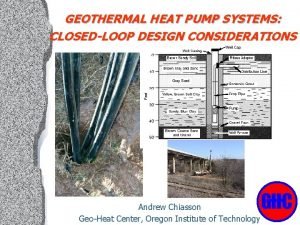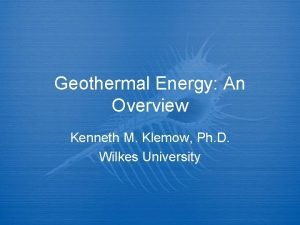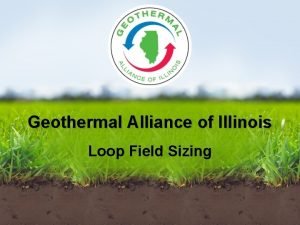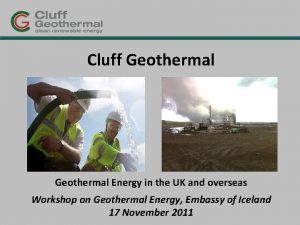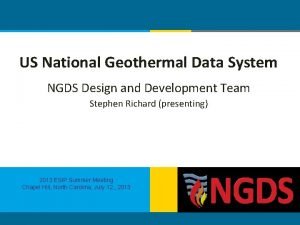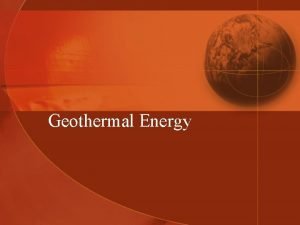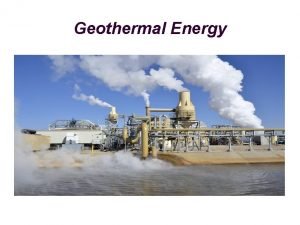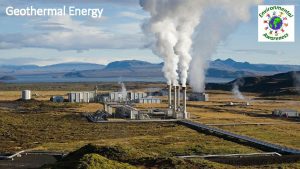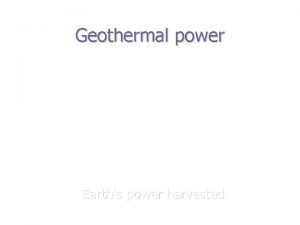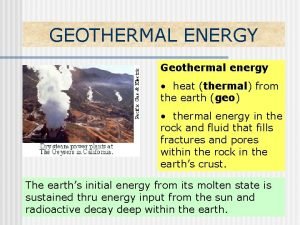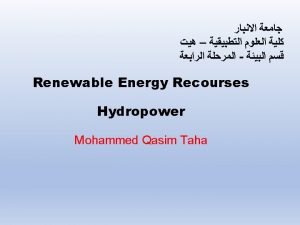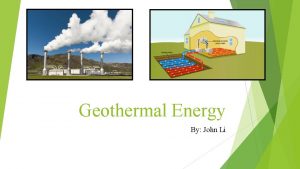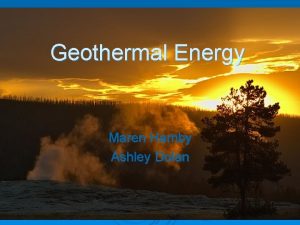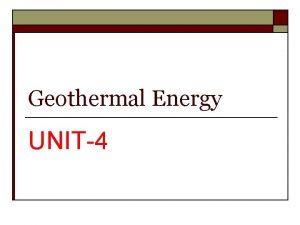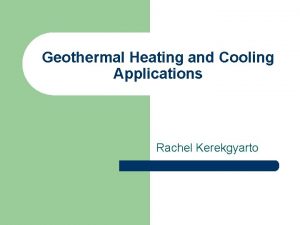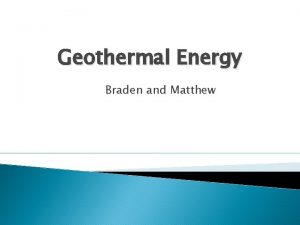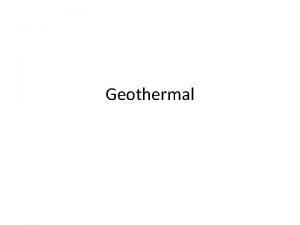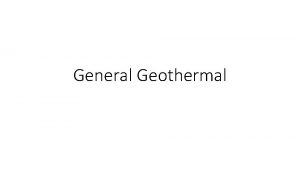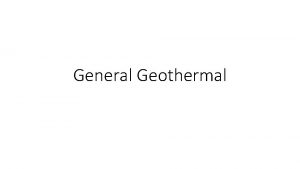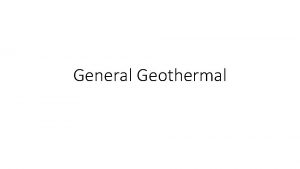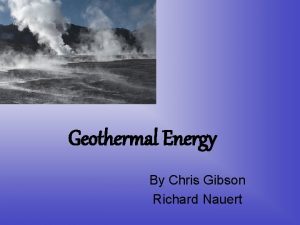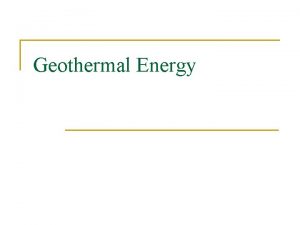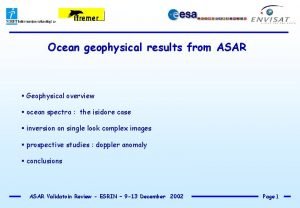Geothermal Energy Geophysical Concepts Applications and Limitations Prof












































- Slides: 44

Geothermal Energy: Geophysical Concepts, Applications and Limitations Prof. Dr. Manfred Koch Department of Geohydraulics and Engineering Hydraulics University of Kassel Winter University, January 6, 2012

Overview 0 Energy statistics 1 Origins of geothermal energy 1. 1 Leftover heat from the accretion of the earth 1. 2 Radioactive decay 1. 3 Heat flow from the earth’s interior 2 Classification of geothermal systems 2. 1 Deep geothermal reservoirs 2. 1. 1 High-enthalpy reservoirs 2. 1. 2 Low-enthalpy reservoirs 2. 1 Hydrothermal systems 2. 1. 2. 2 Petrothermal systems 2. 1. 2. 3 Deep earth tubes 2. 2 Surficial geothermal energy use with heat pumps 2. 3 Geothermal energy from tunnels 2. 4 Geothermal energy from mining shafts 2. 5 Geothermal energy from seasonal storage systems

Overview 3. Use of geothermal energy 3. 1 Direct use 3. 2 Heating and cooling with geothermal energy 3. 3 Electric power generation 4. Economic and regulatory aspects for the use of geothermal energy in Germany 5. Ecological aspects 6. 1 Energy potential 6. 2 Regeneration of the geothermal reservoir 6. Risks 7. 1 Risks of seismic events 7. 2 Risks for building due to vertical deformation of the ground surface and due to drilling 7. 3 Economic risk of a geothermal project 7. Potential of geothermal energy for Germany 8. References

0 Energy statistics/Germany Renewable energy production in Germany Primary energy mix for Germany Users of energy in Germany

0 Energy statistics/geothermal power capacity in the world http: //www. bp. com/liveassets/bp_internet/globalbp_uk_english/ reports_and_publications/statistical_energy_review_2008/ STAGING/local_assets/2010_downloads/renewables_section_2010. pdf

Geothermal Energy and Geothermics n Geothermal energy is that part of the total heat energy stored within the Earth’s interior that is available for human use. That means practically that it is related to the heat energy stored in the upper layers (crust) of the earth. n Although the earth’s stored heat is theoretically finite, its large amount (12. 6 x 1024 MJ) makes geothermal energy practically a renewable energy that can theoretically sustain the energy needs of mankind many times. n Geothermics is the science that deals with theoretical studdy of thermal regime of the earth as well as the engineering aspects to use the earth’s heat for heating / cooling and electric power generations.

1 Origins of geothermal energy n 1. Left-over heat from the time of the accretion of the earth (4. 6 By BC) (30%) n 2. heat generated by the decay of the long-lived radioactive isotopes of uranium (U 238, U 235), thorium (Th 232) and potassium (K 40) (70%).

1 Origins of geothermal energy Temperature distribution in the earth Temperatures in the earth Geothermal gradient in the upper 150 km d. T/dz ~ 30 o. C/km

1 Origins of geothermal energy Mechanisms of heat transport in the earth 1) Heat transport by conduction Fourier’s law Thermal conductivity of rocks

1 Origins of geothermal energy Mechanisms of heat transport in the earth (2) Heat transport by convection Mantle convection driving the plates Numerical simulation of Mantle convection

1 Origins of geothermal energy Heat flow at the earth’s surface n Average heat flow = 60 m. W/m 2 n Compare with Solar Constant S= 1360 W/m 2 n Note the large lateral variations across the surface of the earth Explanation by Theory of Plate Tectonics

1 Origins of geothermal energy The earth’s thermal regime and relation with plate tectonics

1 Origins of geothermal energy The earth’s thermal regime and relation with plate tectonics Plates, plate boundaries and distribution of volcanoes across the earth

1 Origins of geothermal energy Plate tectonics and geothermal fields World pattern of plates, oceanic ridges, oceanic trenches, subduction zones, and geothermal field http: //www. geothermal-energy. org/105, interactive_map. html

2. Classification of geothermal systems/reservoirs The “ideal geothermal reservoir” = high temperatures + water = steam!!!

2. Classification of geothermal systems/reservoirs Thermal processes in an “ideal geothermal reservoir” resulting in the formation of hot steam

2 Classification of geothermal systems Temperature distribution with depth at different locations and classification of geothermal systems in relation of their depths

2. Classification of geothermal systems Use of geothermal energy from surficial, hydrothermal and deep petrothermal reservoirs

2. Classification of geothermal systems 2. 1 Deep geothermal energy reservoirs Classification of geothermal reservoirs in relation to the temperature o. C

2. Classification of geothermal systems 2. 1 Deep geothermal energy reservoirs 2. 1. 1 High enthalpy reservoirs n Characterization of high enthalpy-systems n Mostly in regions with vulkanic activity n Use for generation of electricity (flashmethod) and of process heat n Temperature range: 90 – 300°C n Depending on pressure reservoirs have more steam or water n Steam is reinjected no negativ environmental impact higher productivity

2. Classification of geothermal systems 2. 1 Deep geothermal energy reservoirs 2. 1. 1 High enthalpy reservoirs

2. Classification of geothermal systems 2. 1 Deep geothermal energy reservoirs 2. 1. 1 High enthalpy reservoirs / World map http: //www. geothermal-energy. org/105, interactive_map. html http: //www. geothermie. de/aktuelles/geothermie-in-zahlen/weltweit. html

2. Classification of geothermal systems 2. 1 Deep geothermal energy reservoirs 2. 1. 1 High enthalpy reservoirs/ Examples Laradello geothermal power plant The Geysers geothermal field, California http: //geothermal. marin. org/GEOpresentation/sld 036. htm

2. Classification of geothermal systems 2. 1 Deep geothermal energy reservoirs 2. 1. 2 Low enthalpy reservoirs 2. 1 Hydrothermal systems Thermal power extraction Ptherm= ρ cp Qflow ΔT ρ = density of water cp = specific heat Qflow = flow rate ΔT = Thot-Tcold http: //www. unendlich-vielenergie. de/uploads/media/ Hydrothermale_Geothermi e. pdf

2. Classification of geothermal systems 2. 1 Deep geothermal energy reservoirs 2. 1. 2 Low enthalpy reservoirs 2. 1 Hydrothermal systems/Germany

2. Classification of geothermal systems 2. 1 Deep geothermal energy reservoirs 2. 1. 2 Low enthalpy reservoirs 2. 1. 2. 2 Petrothermal systems /HDR/EGS HDR= Hot Dry Rock Technology EGS = Enhanced Geothermal System http: //www. soultz. net/version -en. htm http: //www. unikassel. de/fb 14/geohydraulik/ Lehre/Geophysik_Geothermi e/Vortraege_2008/Kobs_Hali m_Hot_Dry_Rock. ppt Soulz sous la Foret

2. Classification of geothermal systems 2. 1 Deep geothermal energy reservoirs 2. 1. 2 Low enthalpy reservoirs 2. 1. 2. 3 Deep earth tubes/Super C Aachen Drilling for the Super C Aachen project. Stopped for economic reasons after a depth of 2500 m was reached.

2. Classification of geothermal systems 2. 2 Surficial geothermal energy use with heat pumps Open dublett system horizontal ground loops vertical U-tube loop (most common) In 2009 in Germany 330. 000 ground source heat pumps (GSHP) installed with 51. 000 new installations in 2010

2. Classification of geothermal systems 2. 2 Surficial geothermal energy use with heat pumps/Principle Heat Pump: Coefficient of Performance COP= Qth / Wel ~ 4 -5 with Qth = output heat rate =Qin + Wel = electric power input

2. Classification of geothermal systems 2. 3 Geothermal energy use from tunnels/Switzerland http: //www. geothermie. ch/index. php? p=examp_tunnels http: //www. uni-kassel. de/fb 14/geohydraulik/Lehre/Geophysik_Geothermie/Vortraege_2010/Pfaffel. ppt

2. Classification of geothermal systems 2. 4 Geothermal energy use from old mining shafts Extraction of warm water from mining shaft Doublett-system of pumping and injection wells for water from a mining shaft http: //www. uni-kassel. de/fb 14/geohydraulik/Lehre/Geophysik_Geothermie/Vortraege_2010/Gemmeke. ppt

2. Classification of geothermal systems 2. 4 Geothermal energy use from old mining shafts/Project Heerlen http: //www. unikassel. de/fb 14/geohydraulik/Lehre/Geophysik_Geothermie/Vortraege_2008/Kallert_Remining_Low_Ex. ppt

2. Classification of geothermal systems 2. 5 Geothermal energy use for seasonal storage

3. Use of geothermal energy Lindal-Diagram Geothermal use depend on the temperature of the geothermal reservoir

3. Use of geothermal energy 3. 1 Direct use http: //geothermal. marin. org/G EOpresentation/sld 072. htm

3. Use of geothermal energy 3. 2 Heating and cooling http: //geothermal. marin. org/G EOpresentation/sld 089. htm

3. Use of geothermal energy 3. 3 Electric power generation Carnot thermodynamic efficiency η = W/Qtherm= 1 - Tcold/Thot http: //geothermal. marin. org/GEOpresentation/sld 036. htm

4. Economic and regulatory aspects for the use of geothermal energy in Germany http: //www. unikassel. de/fb 14/geohydraulik/Lehre/Geophysik_Geothermie/Vortraege_2007/ Angebotspotential_Schmidmeier. ppt

5 Ecological aspects of geothermal energy 5. 1 Energy potential of a geothermal reservoir (meaning it is basically a regenerative energy source) 5. 2 Regeneration of a geothermal reservoir (sustainability) 5. 2. 1 Regeneration in a fissured rock system with convective heat transport 5. 2. 2 Pure heat conduction in a solid rock system (requires complicated numerical modeling of the flow and heat transport in a reservoir)

6 Risks of the use of geothermal energy Basel 6. 1 Risks of seismic events http: //www. uni-kassel. de/fb 14/geohydraulik/Lehre/ Geophysik_Geothermie/Vortraege_2009/ Boos_Basel_Projekt. ppt 6. 2 Risks at buildings due to vertical deformations of the earth’s surface or from drilling Staufen http: //www. uni-kassel. de/fb 14/geohydraulik/Lehre/ Geophysik_Geothermie/Vortraege_2009/ Seeliger_Staufen_Projekt. ppt 6. 3 Economic risks http: //www. unikassel. de/fb 14/geohydraulik/Lehre/Geophysik_Geothermie/ Vortraege_2007/Angebotspotential_Schmidmeier. ppt Aachen

7. Potential of geothermal energy for Germany Geothermal temperatures underneath Germany at depths of 1000 m and 2000 m

7. Potential of geothermal energy for Germany Present-day geothermal locations in Germany with different uses Regions with highest geothermal potential with values of hydraulic conductivity for the Molasse region in the south

7. Potential of geothermal energy for Germany /Projection Geothermal heat production Geothermal electrical power production

8. References http: //geothermal. marin. org/GEOpresentation/index. htm http: //www. ceramin. eu/IE/Veranstaltungen/Geothermie/Schellschmidt. pdf http: //www. geothermal-energy. org/314, what_is_geothermal_energy. html http: //www. economist. com/node/16909897? story_id=16909897&fsrc=rss http: //en. wikipedia. org/wiki/Geothermal_energy http: //www. geotis. de/vgs/templates/listing. php
 Disadvantages and advantages of hydroelectric energy
Disadvantages and advantages of hydroelectric energy Inexhaustible energy resource
Inexhaustible energy resource Advantages of geothermal energy
Advantages of geothermal energy Gravity
Gravity Ngdc
Ngdc Gravity method of geophysical exploration
Gravity method of geophysical exploration Reservoir geophysical corporation
Reservoir geophysical corporation Slidetodoc.com
Slidetodoc.com Geophysical fluid dynamics
Geophysical fluid dynamics Biomass energy disadvantages
Biomass energy disadvantages Disadvanteges of solar energy
Disadvanteges of solar energy Geothermal energy distribution
Geothermal energy distribution Geothermal
Geothermal Geothermal energy presentation
Geothermal energy presentation Energy conversions examples
Energy conversions examples Sources of geothermal energy
Sources of geothermal energy Cal energy geothermal
Cal energy geothermal Is geothermal energy potential or kinetic
Is geothermal energy potential or kinetic Brochure about geothermal energy
Brochure about geothermal energy Is fishing a primary activity
Is fishing a primary activity Amish shah net worth
Amish shah net worth Advantages of geothermal energy
Advantages of geothermal energy Geothermal energy definition
Geothermal energy definition Microsoft powerpoint theme
Microsoft powerpoint theme Introduction to genetic analysis tenth edition
Introduction to genetic analysis tenth edition Starr evers starr biology concepts and applications
Starr evers starr biology concepts and applications Energy energy transfer and general energy analysis
Energy energy transfer and general energy analysis Energy energy transfer and general energy analysis
Energy energy transfer and general energy analysis Motivation: from concepts to applications
Motivation: from concepts to applications Orgel diagram is used for
Orgel diagram is used for The rarest and oldest type of geothermal power plant
The rarest and oldest type of geothermal power plant Geothermal pro and cons
Geothermal pro and cons Geothermal education and training
Geothermal education and training Geothermal cost savings
Geothermal cost savings Open loop geothermal well massachusetts
Open loop geothermal well massachusetts Underground heat exchanger
Underground heat exchanger Geothermal education office
Geothermal education office Glhepro
Glhepro Cluff geothermal
Cluff geothermal Landforms
Landforms Geothermal technologies office
Geothermal technologies office Ang pagbabawal ng muro-ami fishing sa pilipinas
Ang pagbabawal ng muro-ami fishing sa pilipinas Southampton geothermal heating company ltd
Southampton geothermal heating company ltd Geothermal enery
Geothermal enery Geothermal data repository
Geothermal data repository

